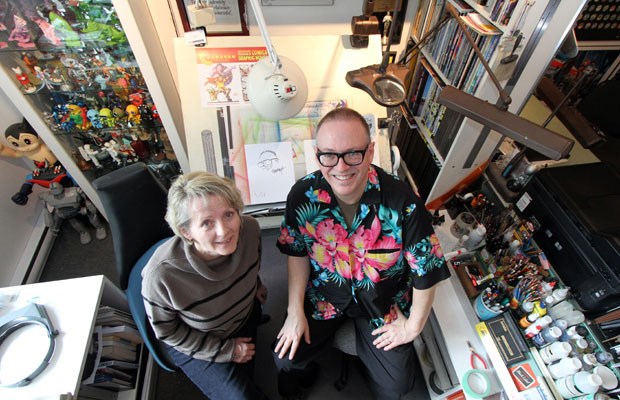Anew program at Camosun College in comics and graphic novels is a first for Canada, its instructors say.
Come September, the college will host a certificate program in visual storytelling for comic books and graphic novels. The program, offered through Camosun's creative writing department, will be taught by the husband-and-wife team of Ken and Joan Steacy.
Ken Steacy is one of Canada's leading comics illustrators and writers. His credits include Spider-Man, Astro Boy, The X-Men and Star Wars. He's worked for the legendary Marvel Comics. And he's collaborated with such writers as Douglas Coupland, Harlan Ellison, Isaac Asimov and Ray Bradbury. Joan Steacy is an artist and graphic novelist who's writing a series of autobiographic novels, Aurora Borealice.
Ken believes their program, Comics and Graphic Novels, is a first for a Canadian public college or university. (A private animation school in Toronto offers courses that are somewhat similar.) Camosun's will be a hands-on course of study; graduates will create and publish a 16-page comic or graphic novel.
Stan Chung, Camosun's dean of arts and science, is pleased Camosun has taken this "risk." There's a demand for such a program (its 16-student capacity is almost filled). And Chung notes Ken Steacy comes armed has a "very powerful" skill set.
Some might raise an eyebrow at a comic/graphic novel program born amid recent cost-cutting measures. Cutbacks included dropping the college's applied communication program, a controversial move that sparked a student protest. However, Chung says the new program will pay for itself, whereas the applied communication program was costing the college.
In a broad sense, the comic/graphic novel program acknowledges the growing acceptance of comics and graphic novels as an artistic and literary form in North America.
It's already big business. Ken Steacy says 82 million comic books and graphic novels are sold annually in Canada and the U.S., representing $420 million-plus in sales.
Despite their popularity, negative stereotypes about comic books linger in North America (illustrated stories are widely accepted in countries such as Japan and France). Some think comic books exist either for children or as an outlet for what Steacy calls "adolescent male power fantasies." There's a prevailing notion adult readers are über-nerds a la the "Comic Book Guy" from The Simpsons.
The world of comics and graphic novels is incredibly diverse, ranging from junk to high brow. Steacy points to Art Spiegelman's ground-breaking graphic novel Maus, the first comic book to win a Pulitzer Prize. The 1991 book chronicles the grim experiences of Spiegelman's father, a Holocaust survivor. Maus is among the texts to be examined in Steacy's program.
Steacy, who lives in the Cedar Hill neighbourhood, is as colourful as one of his comic book illustrations. A bouncy, loquacious fellow, he wore thick-rimmed glasses and a Hawaiian shirt. His neatly organized studio contains such items as a '60s-era Johnny Seven One-Man-Army toy gun, a genuine jet-plane ejector seat, a faux submarine hatch, model planes (he still makes these), a Secret Sam toy (it fires faux-bullets through an attaché case), pilot helmets and an Avro Aircraft cap.
Gareth Gaudlin - coowner of Legends Comics and Books and a noted comic-book artist in his own right - says Steacy is the real deal: a huge talent and a big name in the Canadian comic scene. He jokes, with fondness, that Steacy is also a "self-promoting huckster" who'd be running sideshows if he wasn't a successful comic book writer and illustrator.
Gaudlin agrees that Camosun's agreement to offer a comic-book program serves to legitimize the art form. He compares comics to visual arts movements such as abstract expressionism (think Jackson Pollock), which met with resistance before eventual acceptance.
Steacy says telling stories with illustrations as well as text is trickier than it might seem. One can't overlap the other, in other words, one must avoid a picture that duplicates the words and vise versa. Students will be taught this and other tricks of the trade, such as the essentials of publishing.
Surprisingly, Steacy maintains a lack of innate artistic ability is no impediment to becoming a successful comic artist. Anyone can learn to draw or play the saxophone or dance, he says. It's just a matter of putting in the hours.
He agrees with author Malcolm Gladwell's notion that 10,000 hours of practice are necessary to mastering any skill.
"I don't believe in talent," Steacy said. "I believe in passion, and I believe in hard work."
No doubt his Camosun students will be regaled from a vast store of personal anecdotes Steacy has collected over his 55 years. One is about the time Harlan Ellison - a celebrated sci-fi writer renowned for his abrasiveness - phoned about collaborating on a book project.
Ellison happened to call on the Steacys' wedding day. For a joke, a friend had deposited his gift - an oildripping moped - onto the couple's bed.
"I said, 'Harlen, I just got married and there's a moped on my bed.' He said, 'I don't want to hear about your sex life, you pervert ...' We've been close ever since."
The comic/graphic novel business is highly competitive. Everybody wants to be the next Jack "Captain America" Kirby.
But it's worth it, said Steacy, who added: "It's incredibly rewarding."
achamberlain@timescolonist.com



